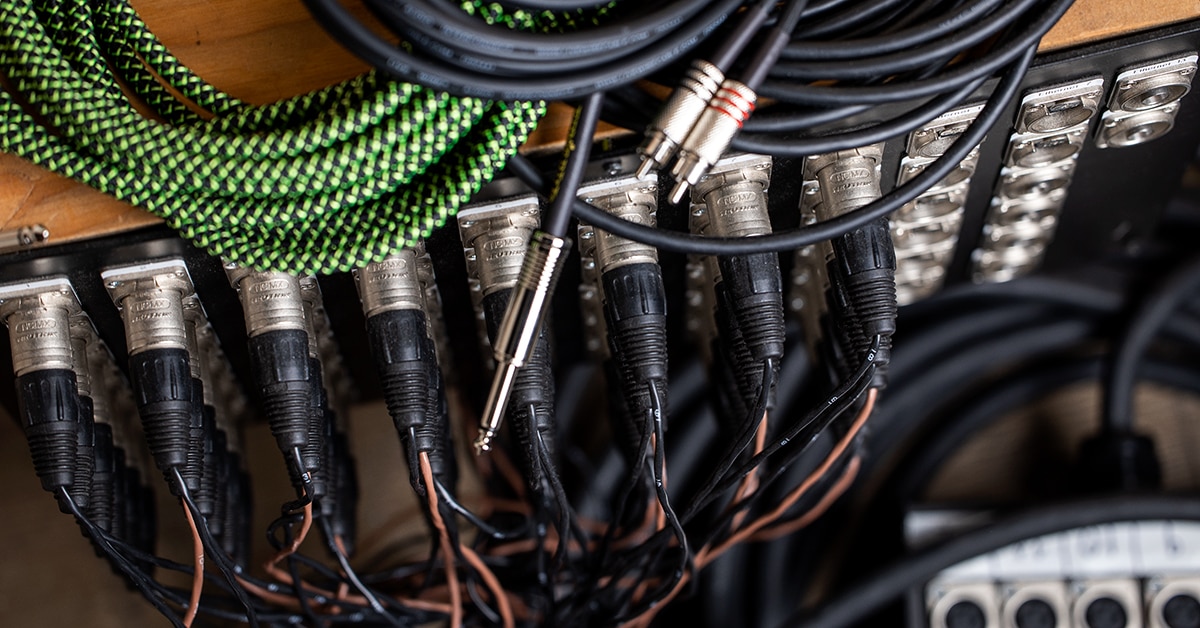While cables may not be the sexiest part of your setup, understanding how they work and what to look for when shopping will eliminate hassles and ensure you get the best possible sound. This guide will get you up to speed on all the in and outs of audio cabling to help you choose the correct cables for your purpose.
Table of Contents
Unbalanced vs. Balanced Cables
Four Common Audio Cable Types
Analog Connectors
Digital Audio Connectors
Optical Cables and Connectors
Judging Cable Quality
Shielding
Other Cable-Related Gear
We’re here to help
Audio cables can seem like a simple thing in concept, until you set out to buy one and realize you didn’t know how much you didn’t know. Although they may be the least exciting components in your stage rig or studio setup, they are some of the most important.
So here is what you need to know, in plain English, to make sure you’re getting the best cable for your gear and your purpose.
Unbalanced vs. Balanced Cables
Unbalanced Cables
Unbalanced cables have two conductor wires: a hot wire that carries the signal, and a common ground wire that is connected to an insulated wrap. The shielded ground wire helps isolate the hot lead from interference that causes hum and other noise. Instrument cables are typically unbalanced, as are many patch cables. Because long unbalanced cables are more prone to noise problems, the length should ideally be kept under 25 feet.
Balanced Cables
To reduce noise, balanced cables add a second signal conductor, referred to as the cold or negative conductor. Both conductors transmit identical signals that are 180-degrees out of phase with each other. As the signal voltage in the hot wire increases, the cold wire’s signal voltage decreases, precisely mirroring the hot signal in reverse. Any noise that is common to both lines will be out of phase with itself, and through a process called common mode rejection, is eliminated. Balanced cables often have XLR or TRS connectors as we discuss below.
While in a few cases balanced and unbalanced cables are interchangeable, the devices you’re connecting will often determine which type is needed. Microphones for example usually require balanced cables as do D.I. (direct injection) boxes that allow direct connection of an instrument or other line-level device to a mixing board or recorder. When you need longer cable runs, balanced cables help ensure a noise-free signal.
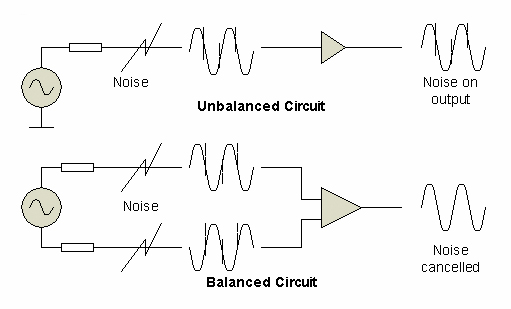
In balanced cables, a second conductor wired out of phase with the first cancels out noise.
Four Common Audio Cable Types
The basic purpose of a cable is to move an electrical signal from one component to another without significantly degrading the signal or introducing noise. The varieties are seemingly endless, and the specs and features can be confusing.
Ultimately, you want cables that are flexible, durable, and that have quality hardware and well-soldered connections. You want to buy cables that are sufficient in length, but not excessively long, as the longer a cable is, the more susceptible it is to noise and signal degradation.
In terms of functions, there are four main types of cables:
- Instrument Cables
- Patch Cables
- Microphone Cables
- Speaker Cables
Instrument Cables
An instrument cable connects a guitar, bass, keyboard, or other electronic instrument to an amplifier or preamp that’s intended for direct connection of an instrument. Instrument cables are designed to carry low-voltage instrument signals, and most often have 1/4" phone plug connectors. Depending on the location of the output jack on your instrument, you may want a male jack with a straight or right-angle connector. In deciding how long a cable to buy, keep in mind that longer cable runs are more prone to picking up interference.
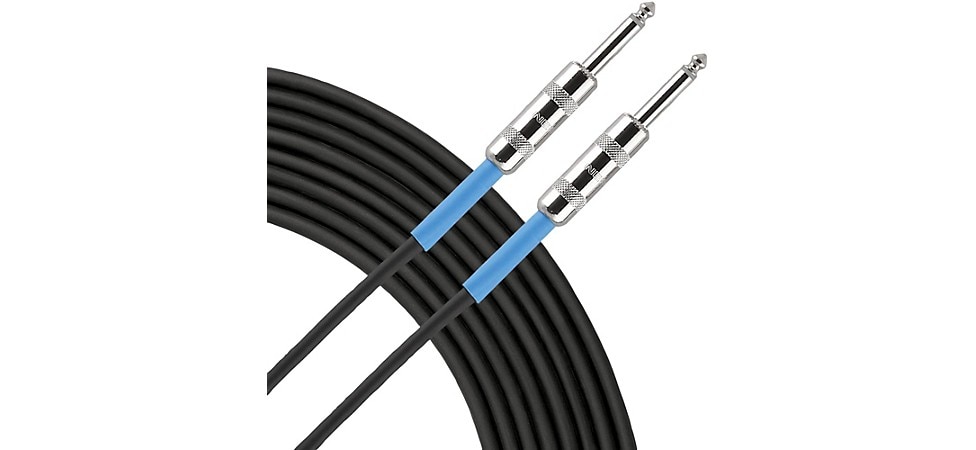
This Livewire Advantage Series instrument cable has straight 1/4" Neutrik onnectors, 20-gauge copper core conducter and quality soldering for low noise.
Browse the complete selection of instrument cables at Musician’s Friend.
Patch Cables
The term “patch cable” generically describes any cable that links various components together. They often are quite short in length and may be used in a PA or recording setups to interconnect gear, or to link effects pedals to each other in a signal chain. They may have balanced or unbalanced conductors (discussed above) depending on their purpose, and can have various kinds of connectors including XLR, 1/4" phone, TRS, or RCA.
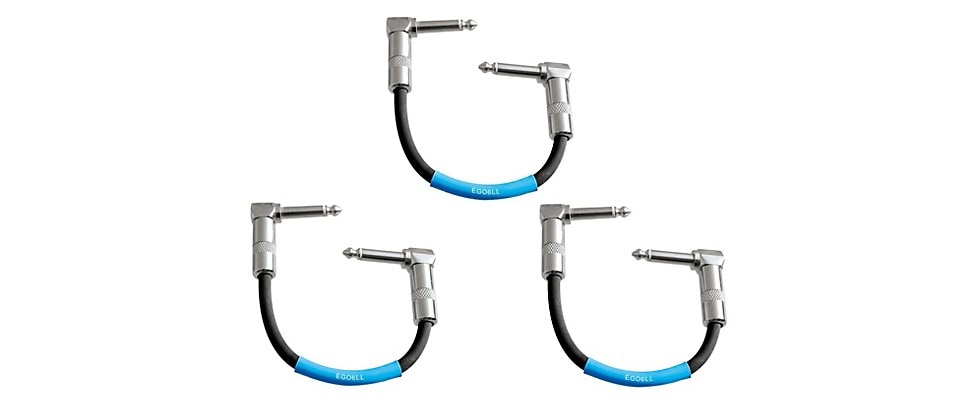
The right-angle 1/4" connectors on these Six-inch Livewire patch cables makes them perfect for connecting effects pedals in a signal chain.
Microphone Cables
Mic cables are shielded and balanced and typically have an XLR male connector on one end and an XLR female connector on the other. Some microphone cables have a TRS, mini plug ,or USB connector on the delivery end for plugging directly into a computer sound card, DAW, or digital recording device. In addition to connecting a microphone to a sound system, mic cables are often used as longer, balanced patch cables—for example connecting a mixing board to powered speakers. They can also be used for D.I. connections between an instrument and a mixing console as well as for lighting effects with DMX control capabilities.
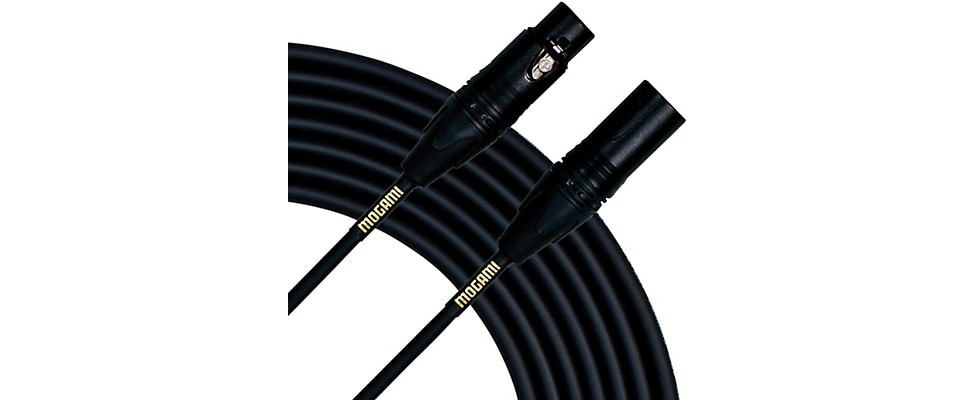
Top pro studios rate Mogami Gold Neglex Quad Mic Cables highly for accuracy, quietness and tough construction.
Browse the entire Musician’s Friend assortment of microphone cables.
Speaker Cables
A speaker cable is an unbalanced cable, and usually has a much heavier gauge conductor than a patch, instrument, or mic cable. Speaker cables need bigger wires because they carry much higher voltage signals. They can have 1/4" phone, banana clip (also called MDP connectors), binding post (as commonly found on consumer stereo amplifiers), or Speakon connectors.
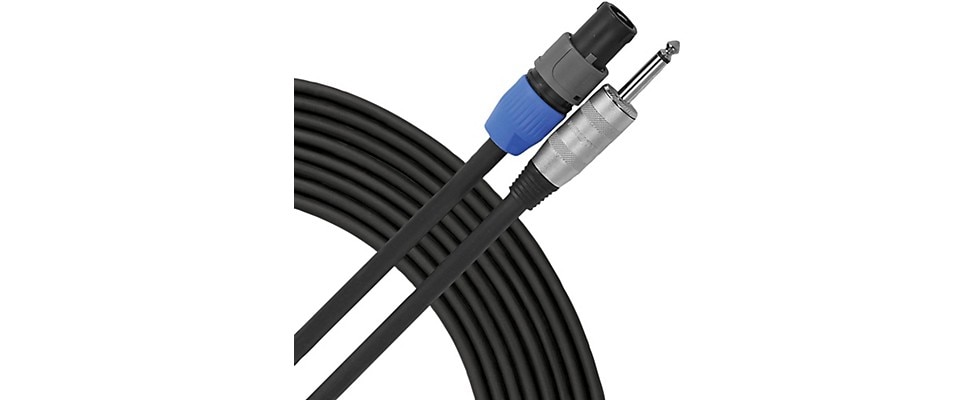
This Livewire Elite 12-Gauge Speaker Cable has a 1/4" phone connector on one end and a Speakon connector at the other, for securely connecting a head amp to a speaker cabinet.
Browse the entire Musician’s Friend selection of speaker cables.
Daisy Chain Cables
Guitarists and bassists who use several effects stomp boxes as part of their signal chain are the main audience for these cables. Designed to easily connect and power multiple guitar effects in a chain, you’ll find a wide assortment of configurations that will help keep your pedalboard tidy and all your effects working optimally.
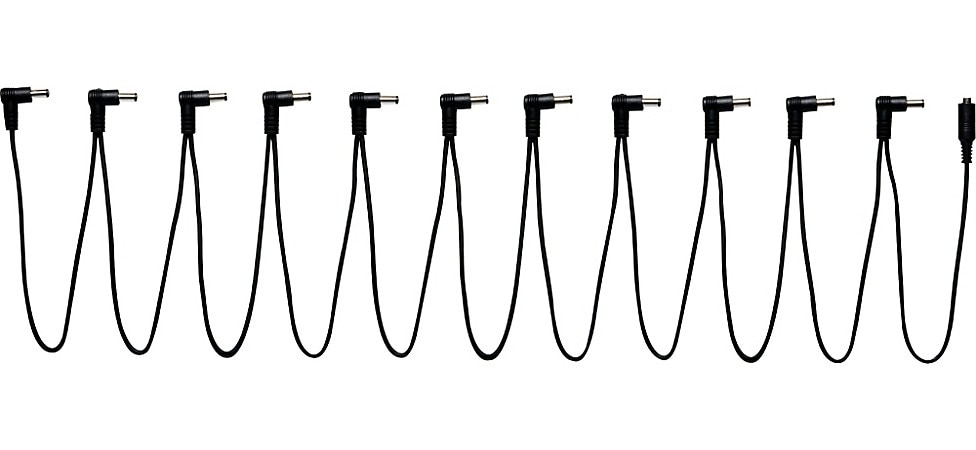
The Godlyke Power-All 11/R Daisy Chain Cable allows you to tidily connect and power up to 11 stompboxes.
Browse the full Musician’s friend selection of daisy chain cable solutions.
Analog Connectors
Here is a quick look at the six most common kinds of connectors you will find at the ends of all of these cables: TS, RCA, banana plugs, and Speakon for unbalanced connections, and TRS and XLR for balanced connections. We’ve also included a couple of less-common connectors that you might run into.
TS
TS stands for “Tip, Sleeve” connectors. Available in ¼” and ⅛” configurations they have two conductors for unbalanced operation and are used with patch, instrument, and speaker cables. There is one insulator ring between the tip, where the hot wire connects, and the sleeve, where the ground (usually the shielding) connects. TS connectors are often referred to as “quarter-inch connectors” (referring to the diameter of the sleeve) or “phone jacks” (because they were originally developed for telephone switchboards). TS cables may also be referred to as “guitar cables” or “line-level instrument cables.”
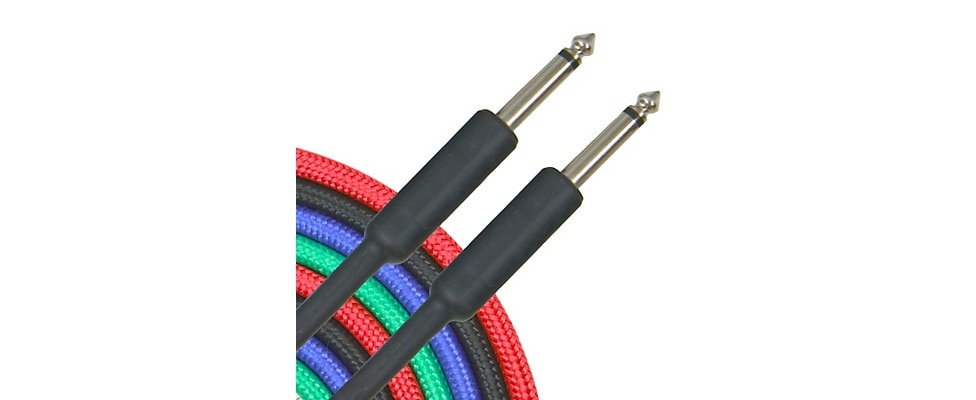
The TS connectors on Musician's Gear Braided Instrument Cables makes them a versatile, entry-level option for groups who need a few extra cables on hand.
TRS
A “Tip, Ring, Sleeve” connector looks like a standard TS connector, but has an additional segment on the shaft called the “ring.” This design allows the connection of two wires, plus a ground (again, usually a shield). These are used for balanced cables, stereo, and as a single connector that handles incoming and outgoing signals. TRS connectors are often found on Y cables used as mixer insert jacks that handle incoming signals with one conductor and outgoing signals with the other.
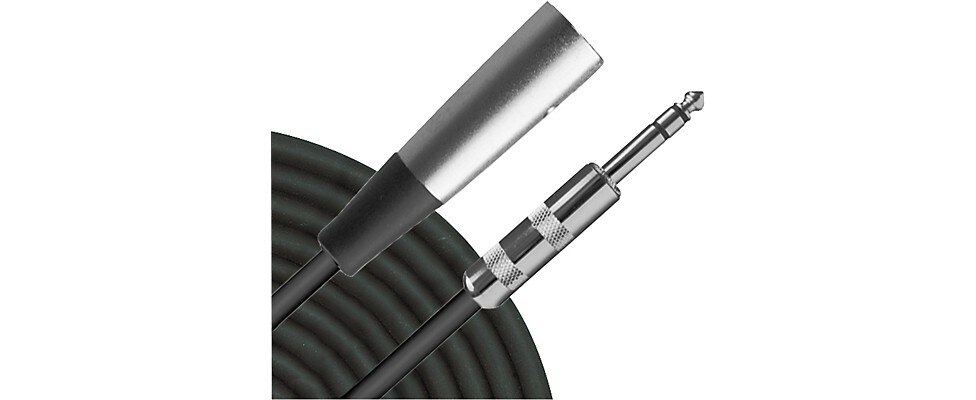
Available in various lengths, the super-affordable and versatile Livewire TRS Balanced Patch Cable gets top reviews from our customers.
Browse the entire Musician’s Friend collection of TRS cables.
RCA
RCA connectors are most commonly used on stereo equipment. In PA systems they’re often used to connect a stereo CD player or other consumer electronics devices to the mixing board. They usually consist of a pair of wires molded together with separate ends color coded for left and right channel in stereo devices. They’re also used with the aux and tape inputs and outputs. Some mixers also have RCA outputs for connecting to a recording device. RCA cables may also be used on S/PIDF devices (discussed below under digital connector types).
“RCA” is derived from the Radio Corporation of America, the company that introduced the design in the 1940s. RCA connectors are also sometimes referred to as “phono connectors” since they’re used to connect turntables.
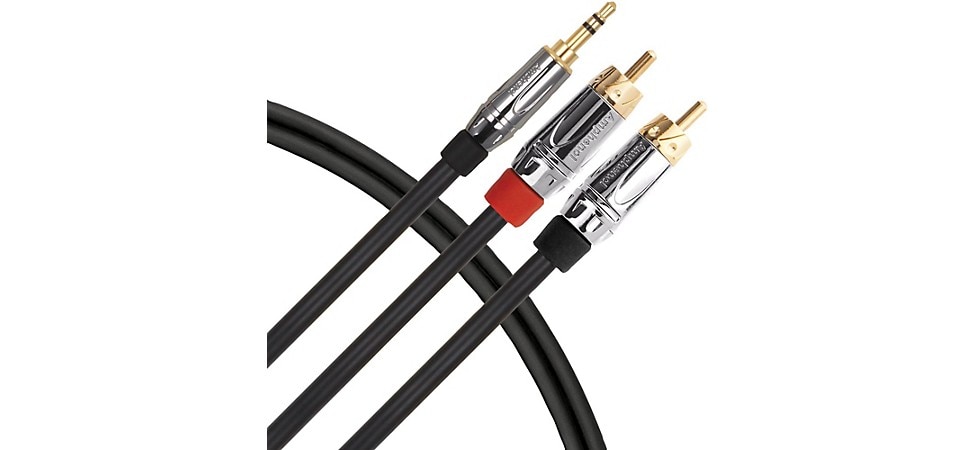
These Livewire Stereo Y-Cables have two RCA male connectors on one end, and a mini TS connector on the other.
Browse the complete Musician’s Friend selection of RCA cables.
Speakon Connectors
Speakon connectors are used to connect speakers, amps, and monitors to PA systems. They are gaining popularity over TS and banana plug connectors, because they lock into place, and therefore cannot be accidentally disconnected.
“Speakon” is a registered trademark of Neutrik, but other companies make compatible products, often described as “twist connectors.”
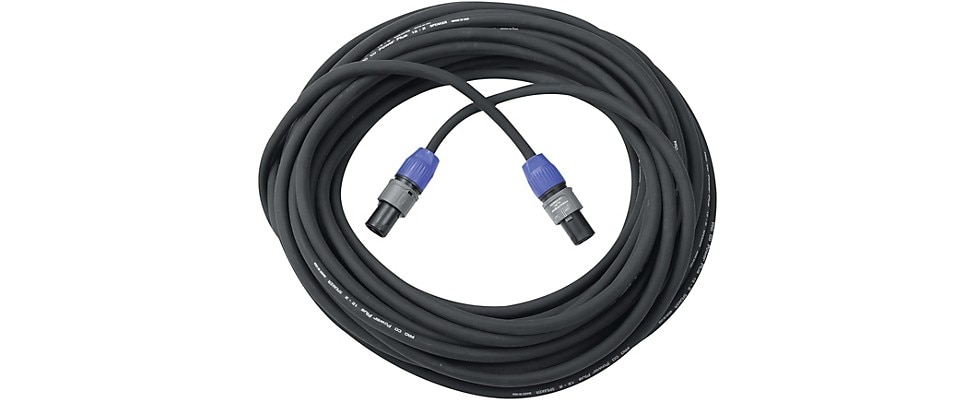
The Livewire Elite Speakon Cable offers a secure connection, twist- and tangle-resistant design, and high-quality conductors that keep your signal noise-free.
XLR
XLR connectors have three pins for the positive, negative, and ground. They are most commonly used on microphone cables, but you will also see them used on balanced patch cables and with DMX-enabled lighting equipment.

The Monster Cable Studio Pro 2000 XLR Microphone cable uses Time Correct technology for the ultimate in detail and soundstage imaging.
1/8" Mini Jack
These jacks can be either TS or TRS. They are used frequently on digital recording gear and sound cards where a small jack is required. They are also used on lightweight headphones, instrument cables that plug into bodypack transmitters of wireless systems, and many consumer electronic devices.
D-Subminiature
Often referred to as “D-Sub”, an abbreviation for D-Subminiature, these are multi-pin connectors commonly used in analog and digital pro audio equipment. D-Sub connectors come in 9-, 15-, 25-, 37-, and 50-pin configurations. The DB25 size D-Sub is commonly used by some audio brands (Tascam and others) for analog/digital I/O. Mackie mixers use the DB25 standard for connecting to a FireWire interface. DB25 connectors are also used in some audio snakes for analog connections, particularly those using the Tascam standard.
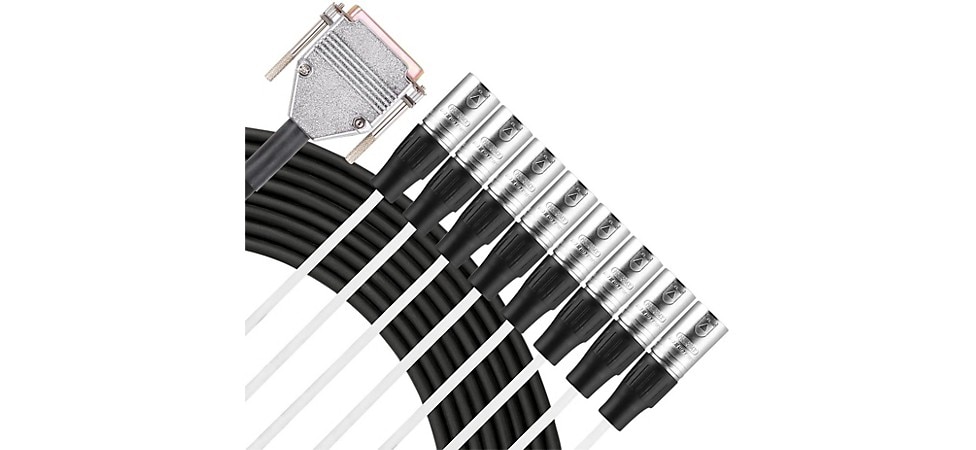
The Livewire 8-Channel DSUB-XLR (F) Snake helps keep your stage or studio cable configuration tidy.
Digital Audio Connectors
Below are some of the most common digital audio cables and connectors required for linking digital mixers, recorders, preamps, and DAWs (digital audio workstations).
A word of caution: In many cases, digital gear uses cables that resemble their analog XLR or RCA counterparts. While these connectors may look the same, the cables are often designed for different resistances, and are not interchangeable with their analog look-alikes.
Browse Musician’s Friend’s entire selection of digital cables and connectors.
MIDI
Musical Instrument Digital Interface cables allow electronic instruments to communicate with peripheral devices. They don’t transmit actual audio, but by signaling every aspect of a musical performance—the note, how long it is held, the velocity of the attack, etc.—MIDI technology defines the sound in the receiving module.
MIDI cables can also communicate control functions to software and synthesizers, so you can control sound and tones with a remote control surface.
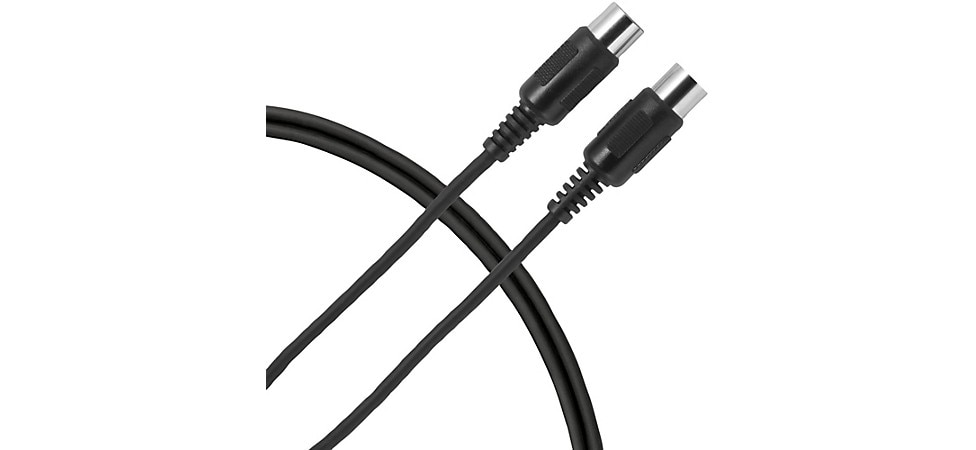
The Livewire Essential MIDI cable features rugged, road-ready 5-pin DIN connectors and molded strain relief.
USB
USB (Universal Serial Bus) cables have become standard for connecting everything from printers to digital audio gear. USB cables have Type A, Type B, Mini-A, Micro-A, Mini-B, Micro-B, or Type C connectors at one end, and a device-specific connector at the other. USB cables can also be used as a power source for some devices. The latest version, USB 3.0, is significantly faster than USB 2.0 and can make a difference in minimizing lag during performances and studio playback of complex material.

For critical audio applications such as recording and DJ work, a premium-quality connector like the Oyaide Neo d+ Series Class B USB Cable ensures stable performance.
FireWire
There are three types of FireWire connectors: 4-pin, 6-pin and 9-pin. The 4-pin connector, or FW400, transfers data at 400 Mbps (megabytes per second). The slightly larger 6-pin connector has the same transfer rate, but also supplies DC power. The 9-pin connector, or FW800, transfers data twice as fast and also supplies power.
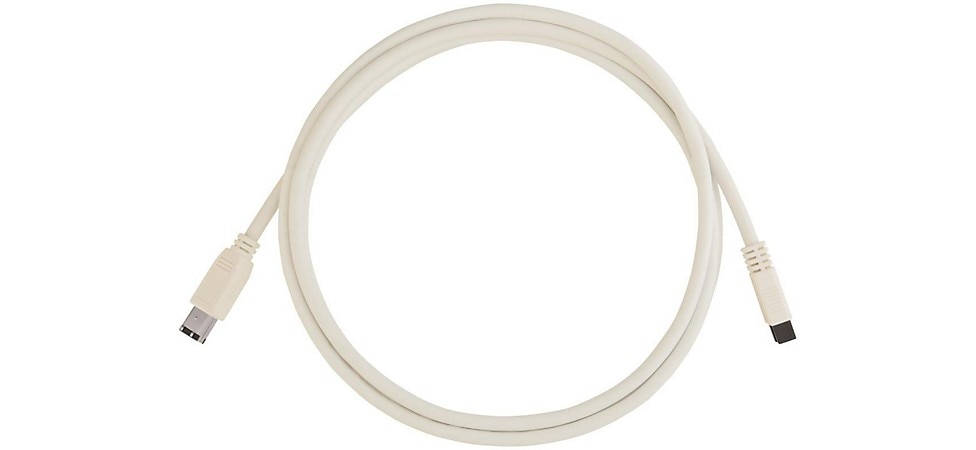
The Livewire Essential Firewire Cable has a 9-pin connector on one end and a 6-pin connector on the other, for connecting older FW400 devices to FW800 ports.
Thunderbolt
Originally codenamed Light Peak, Thunderbolt is a hardware interface that allows connecting various peripherals including some pro audio equipment to computers using a Mini DisplayPort (MDP) connector. Although the interface was originally limited to Apple Products such as the MacBook Pro, it can be implemented with other audio standards such as PCIe graphics cards using HDMI adapters.

The Apple Thunderbolt Cable is the perfect choice for high-bandwidth data transfer.
HDMI
HDMI (High-Definition Multimedia Interface) has become the standard for connecting consumer electronics such as DVD and Blu-Ray players to televisions. Its ability to transfer uncompressed video and audio signals has led to its adoption in pro audio gear. There are five connector types (Type A through Type E) each with unique pin configurations. Refer to your manufacturer’s specs to determine which type is correct for your gear.
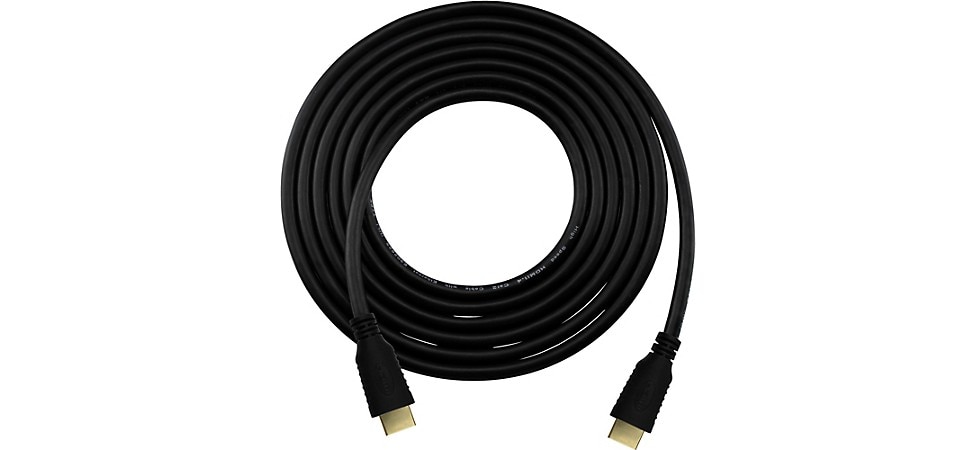
The Pro Co StageMASTER HDMI Cable is available in multiple lengths, ranging from 3 to 75 feet.
Optical Cables and Connectors
Optical cables transmit digital audio as pulses of light, which make them almost completely immune to interference. They are surround-sound capable, but can’t handle higher-resolution formats such as those on Blu-Ray discs.
ADAT (Alesis Digital Audio Tape) Optical Interface, more commonly known as ADAT Lightpipe, is the widely accepted standard for digital audio transfer on optical cables. It transfers eight channels of digital audio on a special cable with an Alesis-specific ADAT connector.

Livewire Elite Optical Data Cable feature premium, heavy-duty fiber-optic cable with Toslink connectors for ADAT "light pipe" optical connections, audio interfaces and recording equipment.
S/PDIF
The Sony/Philips Digital Interface Format (S/PDIF) outputs audio over shorter distances. These connectors use either optical or coaxial cables. Coaxial cables are similar in quality to optical cables, but less common. They use RCA connectors, but these cables are not interchangeable with analog RCA cables.

The Livewire Elite S/PDIF cable features premium, heavy-duty 75 ohm coax cable with gold-plated connectors and spring strain relief.
AES/EBU
Officially AES3, these three-conductor cables transfer two channels through several types of single connectors—usually XLR connectors, and usually from CD and DVD players to amplifiers and TVs. Developed by the Audio Engineering Society (AES) and the European Broadcasting Union (EBU) in the early 1980s, and later revised in 1995 and 2003, it is the transfer protocol on which the more consumer-friendly S/PDIF was based. Because of differences in resistance, an XLR microphone cable, although it has the same connectors, will not work as an AES/EBU cable.

The Hosa EBU-010 XLR Male to XLR Female AES/EBU Cable features 110-ohm cable minimizes signal reflections for accurate data transfer.
BNC Connectors
Bayonet Neill-Concelman connectors were originally designed for military use, but are now commonly used on video and audio testing equipment. The bayonet-style connector is used with miniature and subminiature coaxial cables in radio-frequency equipment and video gear.
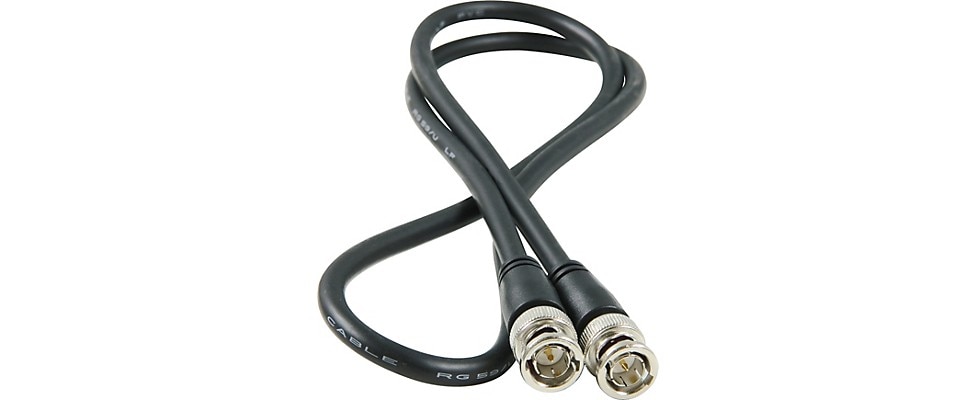
This Hosa RG 59 Cable has a male BNC connector on each end for video or Ethernet connections.
Judging Cable Quality
The basic purpose of a cable is to move an electrical signal from one component to another without degrading the signal significantly or introducing noise. There are expensive, audiophile-quality cables that are designed to keep the signal pristine and noise-free. Most musicians do not need quite this level of cable performance for their stage gear, but still, you want cables of high quality. Quality cables will deliver better sound, and if you sound better, you’ll play better.
Where cables for your studio setup are concerned, audiophile-level quality is more important. Noise-free transmission of signals is essential to high-quality recording, mixing, and mastering work.
Other “quality” features, such as gold-plated connectors and oxygen-free copper wire, are not necessarily important. Gold-plating may lessen resistance, but is more subject to wear than nickel-plating, so it may be a liability on connectors that are plugged and unplugged a lot. Oxygen-free wire may offer slightly less resistance, but larger-gauge conductors help more.
Mainly you want cables that are flexible, durable, and that have quality hardware and well-soldered connections.
Other desirable features include epoxy potted or hot glue connectors (filled with one substance or the other to prevent the wire ends from moving). Heat-shrunk plastic sleeves around wires and terminals help prevent wires from moving.
These features are especially valuable on instrument cables that get pulled, stepped on, and plugged and unplugged frequently. No instrument cable will last forever, but good ones last longer. You also want to buy cables that are sufficient in length, but not excessively long (the longer a cable is, the more susceptible it is to noise).
Shielding
All audio cables with the exception of speaker wires and optical cables are shielded to protect the signal from interference that causes noise. The shielding is most often a wire braid that surrounds the insulator for the center conductor(s). The purpose of shielding is to protect the signal from sources of noise, such as radio transmissions, AC power cords, fluorescent lighting, rheostat dimmers, and some appliances. When you hear radio chatter through your amp, it usually means that the shielding around your amp’s gain components is inadequate, but your instrument cable’s shielding can also be the problem. Good shielding blocks interference and also may serve as a ground.
There are several types of shielding. These are types you’ll find most often:
Braided Shield
The most common is the braided shield. Small wire strands are braided to form a sheath around the insulation of the signal-conducting wire. This type of shielding is flexible and durable. Onstage mic and instrument cables are constantly being bent, pulled, and stepped on, and braided shielding holds up best under these conditions.
Serve or Spiral-Wrapped Shield
Another type of shielding is the spiral-wrapped or serve shield. This sheath is formed by wrapping a flat strip of wire strands around the center wires in a spiral. The serve shield, while it lacks the tensile strength of a braided shield, is more flexible than a braided shield because it stretches when the cable is bent. It is less resistant to radio frequency (RF) interference, because it is actually a coil and has inductance. It is also easier to manufacture so cables using serve shielding are usually less expensive.
Foil Shield
The foil shield is a Mylar-backed aluminum tube that terminates at a copper drain wire. It provides 100% coverage, but since aluminum is a poor conductor of electricity, it also interferes with signal transfer. Foil shielding is inexpensive and easy to make, but it is also fragile and breaks down easily with repeated flexing. It is best used in small patch cables and stereo cables that don’t move much once they are connected.
Other Cable-Related Gear
If you are setting up a sound system for live performances or a studio setting, there are a few more pieces you may want to consider or at least be aware of. Below is a quick look at adapters, testers, and snakes.
Cable Adapters
As technology changes, and you add pieces to your stage gear or studio setup, you will eventually need to connect equipment with incompatible jacks and cables. There is an adapter out there for just about every situation. If in doubt, call a Musician’s Friend Gear Head at 877-880-5907 for a recommendation on the proper adapter.
Cable Testers
Even the best cable will eventually fail, and the more you use your sound equipment, the faster you will go through them - especially if you’re taking it on the road. A cable tester is a simple tool that verifies intended signals are working, and no unintended signals are being carried. If you have a problem with your system, a cable tester can quickly help you determine what and where the problem is.
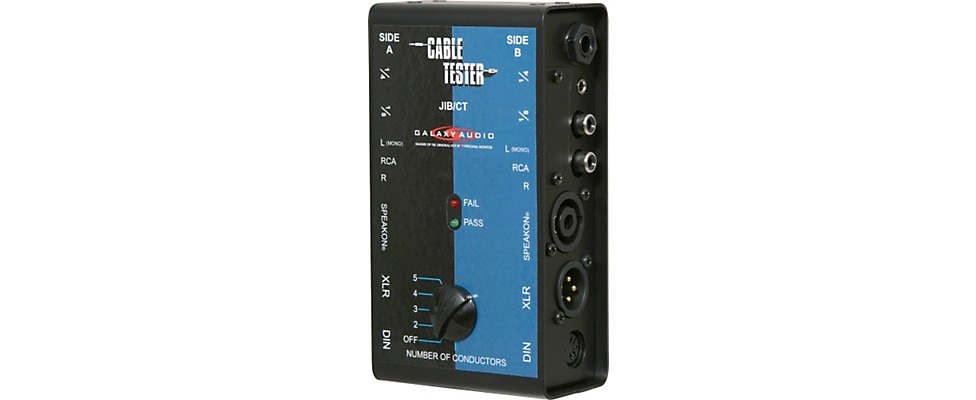
The Galaxy Audio Cable Tester quickly and easily tests XLR, 1/4", 1/8", Speakon, stereo RCA, and DIN (MIDI) cables, making it an essential tool for musicians and sound engineers.
Browse the Musician's Friend selection of cable testers and other audio test equipment.
Cable Snakes
Snakes are essentially bundled sets of cables. Stage snakes may contain microphone, patch, or speaker cables and are used for two-way connection between the stage and mixers and other PA equipment. They have a fan of connectors on one end, and a box on the stage end that houses a panel of connectors. In shopping for a snake, the length and the type of connections are the main considerations. There are also audio snakes for studios that bundle various cables needed for connecting studio components.
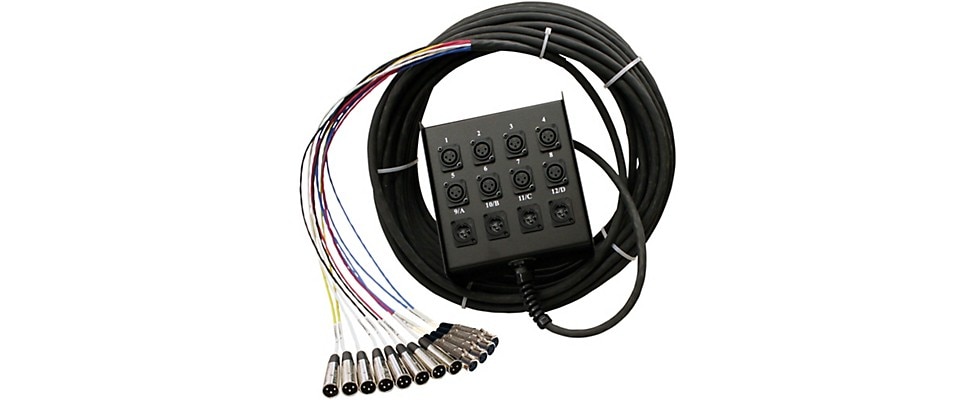
Very ruggedly built with Neutrik D connectors and serious strain relief on all cables, the Pro Co StageMASTER 12-Channel Snake has 12 sends and 4 returns.
Explore the complete selection of audio cable snakes at Musician’s Friend.
We’re Here to Help
The Musician’s Friend Cable Finder page makes it easy to hone in on what you’re looking for.
After reading this guide, if you’re not sure which cables or connectors are right for your situation, call an expert Musician’s Friend Gear Advisor. We’ll help you make all the right connections!





































































































































